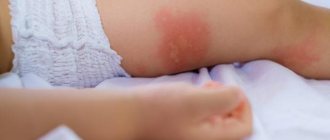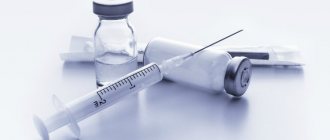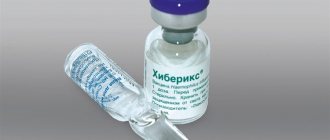Description of the drug
The Hiberix vaccine is intended for the prevention of purulent-septic diseases caused by Haemophilus influenzae type b (hemophilus influenzae), such as meningitis (inflammation of the meninges), sepsis (generalized bacterial infection), purulent arthritis (often accompanied by ostemyelitis), epiglotitis (inflammation of the epiglottis), pneumonia, inflammation of the subcutaneous tissue.
Hemophilus influenzae infection is transmitted by airborne droplets (and in children of the first year of life, contact transmission is also possible) and is extremely dangerous for children in the first years of life, since most often Hemophilus influenzae causes complications of a common acute respiratory viral infection, which can lead to serious life-threatening conditions (sepsis, meningitis, epiglotitis). Therefore, it is extremely important to form strong immunity in a child against Haemophilus influenzae type b.
The Hiberix vaccine contains purified Haemophilus influenzae type b capsular polysaccharide conjugated to tetanus toxoid.
The vaccine meets WHO requirements for the production of biological products and for Hib conjugate vaccines.
The Hiberix vaccine is used in more than 100 countries around the world. Vaccination against Hib infection has made it possible to virtually eliminate Hib meningitis and reduce the incidence of severe pneumonia by 20%. Vaccination has led to the almost complete disappearance of epiglottitis: in Finland, the incidence of epiglottitis has decreased from 7.6 to 0.0 per 100,000 children under 4 years of age. Similar data are available for other countries. The US Food and Drug Administration (FDA) has approved Hiberix for booster vaccination in children in the second year of life. The Hiberix vaccine was registered in Russia in 2004.
Hiberix
Release form, composition and packaging
Lyophilisate for the preparation of a solution for intramuscular and subcutaneous administration in the form of a powder or dense mass of white or grayish-white color; the attached solvent is a colorless, transparent, odorless liquid, free of visible mechanical inclusions. 1 fl. (1 dose) purified capsular polysaccharide (PRP) Hib* 10 mcg conjugated to tetanus toxoid (approximately 30 mcg). Excipients: lactose as a stabilizer (10.08 mg per 1 dose). Solvent: 0.9% sodium chloride solution - 0.5 ml (per 1 dose).
- * Haemophilus influenzae type b 20,752. The vaccine meets WHO requirements for the production of biological products and for Hib conjugate vaccines. Lyophilisate for the preparation of a solution for intramuscular and subcutaneous administration in the form of a powder or dense mass of white or grayish-white color; the attached solvent is a colorless, transparent, odorless liquid, free of visible mechanical inclusions. 1 fl. (10 doses) purified capsular polysaccharide (PRP) Hib* 100 mcg conjugated to tetanus toxoid (approximately 30 mcg per dose). Excipients: lactose as a stabilizer (10.08 mg per 1 dose). Solvent: 0.9% sodium chloride solution - 5 ml (for 10 doses).
- * Haemophilus influenzae type b 20,752. The vaccine meets WHO requirements for the production of biological products and for Hib conjugate vaccines.
Clinical and pharmacological group: Vaccine for the prevention of diseases caused by Haemophilus influenzae type b.
pharmachologic effect
Vaccine for the prevention of diseases caused by Haemophilus influenzae type b. Antibodies with a protective titer of ≥0.15 μg/ml appear 1 month after the end of the vaccination course in 95-100% of children, and 1 month after revaccination - in 100% of children. Moreover, 94.7% of the latter had an antibody titer of ≥10 μg/ml. Hiberix does not protect against diseases caused by other types of Haemophilus influenzae, and bacterial meningitis of other etiologies
Pharmacokinetics
The pharmacokinetics of the Hiberix vaccine have not been studied.
Indications
- prevention of infection caused by Haemophilus influenzae type b in children aged 6 weeks to 5 years.
Dosage regimen
Children aged 6 weeks - 6 months: when starting vaccination before 6 months of age, the course consists of three vaccinations at intervals of 1 month (2, 3, 4 or 3, 4, 5 months of life) or 1.5 months (3, 4.5, 6 months life) or 2 months between doses (2, 4 and 6 months of life). The vaccination schedule may vary from country to country; In the Russian Federation, vaccination against infection caused by Haemophilus influenzae type b begins at 3 months of age. Revaccination is carried out once at the 2nd year of life. Vaccination is recommended to be carried out simultaneously with vaccination against polio, whooping cough, diphtheria and tetanus. In this regard, in accordance with the National Calendar of Preventive Vaccinations of the Russian Federation, a schedule of 3, 4.5, 6 months with revaccination at the age of 18 months is preferable.
Children aged 6 months - 1 year : when vaccination begins after 6 months of age, the course consists of 2 vaccinations with an interval of 1 month. Revaccination is carried out once at the 2nd year of life.
For example, vaccination at 6 and 7 months of a child’s life and revaccination at 18 months of a child’s life. The vaccine can be given at the same time as vaccination against polio, whooping cough, diphtheria, tetanus, measles, mumps and rubella. Children aged 1-5 years: when starting vaccination after 1 year, the vaccine is administered once.
Rules for preparing and administering the solution
The vaccine is administered intramuscularly. For patients with thrombocytopenia and other disorders of the blood coagulation system, the vaccine is administered subcutaneously. Before use, the solvent should be inspected for the presence of foreign particles and the physical properties of the solution.
- If foreign particles are present or the appearance of the solution changes, it should not be used. Immediately before use, add the supplied solvent to the vaccine vial at the rate of 0.5 ml per dose.
Shake the bottle well until the contents are completely dissolved. The lyophilisate usually dissolves within no more than 1 minute. The dissolved drug is a clear, colorless liquid. If it looks different, or if there are foreign particles, the vaccine is not used. A new needle should be used to administer the vaccine.
When using a vaccine in a multi-dose package, a new sterile syringe and needle must be used to withdraw the drug each time. The drug should be removed from the bottle under strict aseptic technique to prevent contamination of the contents. The drug from an opened bottle should be used during the working day. Under no circumstances should Hiberix be administered intravenously.
Side effect
Local reactions: in the first 48 hours after vaccine administration, the following are possible: slight spontaneously disappearing hyperemia; slight swelling and pain at the injection site. Systemic reactions: in the first 48 hours after administration of the vaccine, fever, loss of appetite, restlessness, nausea, diarrhea, and unusual crying may develop, which are usually mild and do not require therapy. Allergic reactions (including anaphylactic shock) were extremely rarely recorded.
Contraindications
- acute infectious and non-infectious diseases;
- exacerbation of chronic diseases (vaccinations are carried out 1 month after recovery);
- mild forms of respiratory, intestinal and other infections, accompanied by an increase in body temperature (vaccinations can be carried out after the temperature has normalized); hypersensitivity to vaccine components, including tetanus toxoid;
- development of allergic reactions to previous administration of the Haemophilus influenzae type b vaccine.
special instructions
HIV infection is not a contraindication to the use of Hiberix. Due to the possibility of developing an anaphylactic reaction in isolated cases, vaccinated people should be under medical supervision for 30 minutes, and treatment rooms should be provided with anti-shock therapy. Although administration of Hiberix may produce a minor immune response to tetanus toxoid, administration of the vaccine is not a substitute for tetanus vaccination.
Individuals who have received Hiberix excrete capsular polysaccharide in the urine, so determination of the antigen in urine within 1-2 weeks after vaccination has no diagnostic value in cases of suspected infection caused by Haemophilus influenzae type b.
Overdose
Data on overdose of the Hiberix vaccine are not provided.
Drug interactions
In accordance with the rules existing in the Russian Federation, Hiberix can be administered simultaneously (on the same day) with other vaccines of the National Preventive Vaccination Calendar, as well as inactivated vaccines of the vaccination calendar for epidemic indications.
In this case, the drugs should be administered with different syringes to different parts of the body. In persons receiving immunosuppressive therapy, as with other vaccines, an adequate immune response may not be achieved.
Storage conditions and periods
The vaccine packaged with the solvent should be stored in a place protected from light at a temperature of 2° to 8°C; do not freeze. The vaccine, packaged separately from the diluent, should be stored and transported at a temperature of 2° to 8°C, protected from light. Freezing is not allowed.
The solvent, packaged separately from the vaccine, should be stored and transported at a temperature of 2° to 25°C; do not freeze. The shelf life of the vaccine is 3 years, the solvent is 5 years. Keep the vaccine and diluent out of the reach of children.
Compatibility with other vaccines
The Hiberix vaccine can be administered simultaneously with all drugs from the national schedule of preventive vaccinations on the same day, in different parts of the body, in different syringes, with the exception of the BCG vaccine.
The use of the Hiberix vaccine in combination with other vaccinations does not affect their immunogenicity (ability to develop immunity). Tolerability of vaccines does not deteriorate, and the number of adverse reactions does not increase. Administering several vaccines on the same day does not place an excessive burden on the immune system. Hiberix can be used to continue and complete a course of vaccination started with other vaccines against Haemophilus influenzae. All vaccines in the Russian national vaccination calendar are interchangeable.
Vaccination scheme
According to the National Calendar of Preventive Vaccinations of Russia, immunization with the Hiberix vaccine consists of 3 doses of the vaccine administered at 3-4.5-6 months of life; revaccination is carried out at 18 months. Vaccination against hemophilus influenzae is included in the National Calendar of Preventive Vaccinations of Russia by Order No. 51 of January 31, 2011. The Hiberix vaccine can be administered simultaneously with vaccination against polio, whooping cough, diphtheria, and tetanus.
The course of primary immunization depends on the age at which vaccination began. When vaccination begins at the age of 6 weeks to 6 months: 3 injections at intervals of 1-2 months. Revaccination is carried out once a year after the 3rd vaccination. Thus, the first injection is carried out, then the second injection 45 days after the first, then the third 45 days after the second. The immunization course is completed by revaccination, carried out one year after the third one is completed.
When starting vaccination between 6 and 12 months of age: 2 injections 1 month apart. Revaccination is carried out once at the age of 18 months. Thus, the first injection is carried out, then the second injection 30 days after the first. The immunization course is completed by revaccination, carried out one year after the second one is completed.
When starting vaccination between 1 and 5 years of age: single injection.
Antibodies with a protective titer of ≥0.15 μg/ml appear 1 month after the end of the vaccination course in 95-100% of children, and 1 month after revaccination - in 100% of children.
Advantages of vaccination with Hiberix at the Miracle Doctor clinic
- using the best drugs. The Hiberix vaccine (manufactured in Belgium) meets all the World Health Organization requirements for Hib vaccines;
- highly qualified pediatricians and medical personnel;
- availability of vaccination. The Miracle Doctor clinic offers services at an average cost in Moscow;
- convenient location. The pediatrics department is located a 10-minute walk from the Ploshchad Ilyich metro station.
The Miracle Doctor clinic provides vaccination against hemophilus influenzae up to 5 years of age. An appointment to be examined by a pediatrician before vaccination can be made on the website or by calling the clinic.





